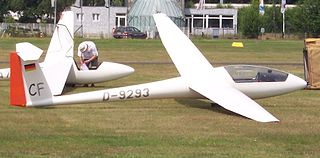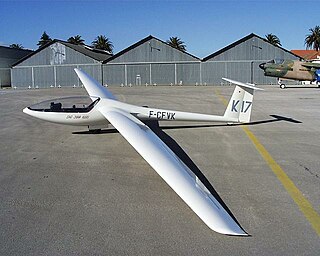
The Glaser-Dirks DG-200 is a 15 metre class glider built by Glaser-Dirks, now DG Aviation GmbH

The LS11 or AFK1 is a prototype Two-Seater Class sailplane currently in development at Akaflieg Köln e.V.. The LS11 first flew on 5 November 2005.

The Rolladen-Schneider LS4 is a Standard Class single seat glider manufactured by Rolladen-Schneider Flugzeugbau GmbH between 1980 and 2003.

The Schempp-Hirth Mini Nimbus is a 15 Metre-class glider designed and built by Schempp-Hirth GmbH in the late 1970s.

The Rolladen-Schneider LS1 is a Standard Class single-seat glider manufactured in Germany by Rolladen-Schneider from 1968 to 1977.

The Schempp-Hirth Janus is a high performance two-seat glider that was built by Schempp-Hirth GmbH. It was the first high-performance two-seater.

The Glaser-Dirks DG-300 is a Standard Class single-seat high-performance glider built from glass-reinforced plastic. The DG-300 was designed by Wilhelm Dirks and manufactured by Glaser-Dirks Flugzeugbau's Slovenian partner company Elan (company). A total of 511 of all versions were built since production started in 1983. Representative contemporary types from competing manufacturers are the Rolladen-Schneider LS4 and the Schempp-Hirth Discus.
The Rolladen-Schneider LS10 is an 18 metre sailplane designed in Germany by Rolladen-Schneider. A prototype flew in 2003.

The Glaser-Dirks DG-400 is a single-seat self-launching motorglider that was produced by Glaser-Dirks between 1981 and 1992. It was the first self-launching motorglider with retractable engine and propeller to be produced in large numbers.
The DG Flugzeugbau DG-800 series is a family of 15 metre and 18 metre single-seat gliders and motor gliders produced by Glaser-Dirks since 1993 and by DG Flugzeugbau GmbH after 1997. It is the successor to the DG-400 and the DG-600 models.

The DG Flugzeugbau DG-1000 is a two-seater class glider built by DG Flugzeugbau. It first flew in July 2000 at Speyer in Germany. There are four models, with 18- and 20-metre wings of HQK-51 profile. The latest DG-1001 variant replaced the DG-505 in production.

The Glaser-Dirks DG-500, and later the DG-505, is a two-seat glider of glass-reinforced plastic and carbon fiber reinforced plastic construction, manufactured in the DG Flugzeugbau GmbH in Bruchsal, Germany. It first flew in 1987.

The Glasflügel 206 Hornet is a Standard Class sailplane produced in Germany between 1975 and 1979. Of conventional sailplane design with a T-tail, it replaced the Standard Libelle, featuring composite construction throughout. Differences from the earlier aircraft included a redesigned canopy, retractable monowheel landing gear, and provision for 100 kg (220 lbs) of water ballast.

The SZD-59 Acro is a single-seat glass composite glider for aerobatics and cross-country flying by PZL Allstar of Bielsko-Biała, Poland.
AMS Flight is a manufacturer of gliders, motorgliders and ultralight aircraft. It is based in Begunje na Gorenjskem, Slovenia.
Akaflieg Darmstadt is one of approximately twenty aviation groups attached to German universities. Akaflieg is an abbreviation for Akademische Fliegergruppe, an academic group of students and faculty from a German University.
The Akaflieg Darmstadt D-38 is a German, single-seat, Standard Class sailplane that was designed and built by the Fliegergruppe of Darmstadt University.
The Akaflieg Braunschweig SB-12 is a single seat, Standard Class sailplane designed around 1980 by German technical university students to test out a new wing profile from the German Aerospace Centre. It was not intended for production, but the sole SB-12 remains active in 2010.
The VTC Delfin is a competition single seat Standard class glider designed and built in Yugoslavia in the 1960s. It had some success in national competitions and went into small scale production.













